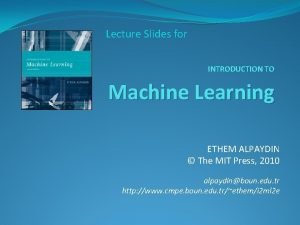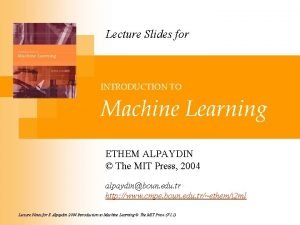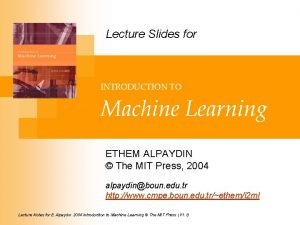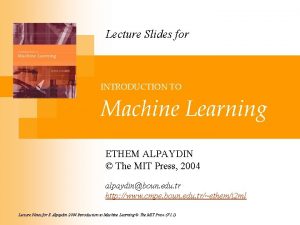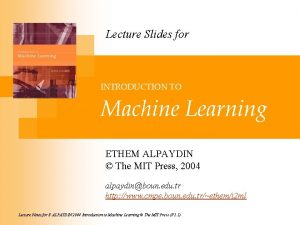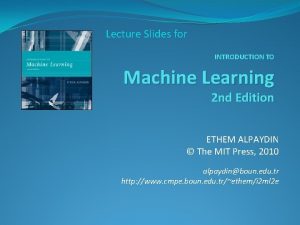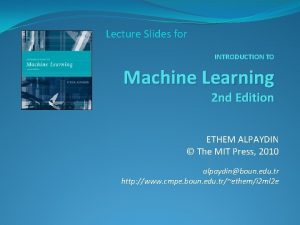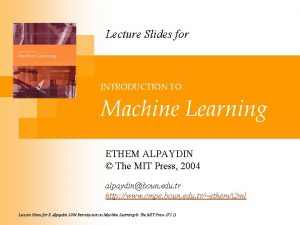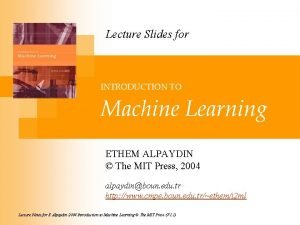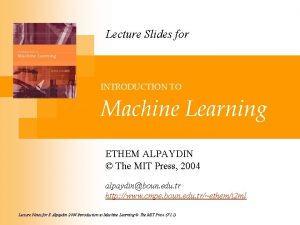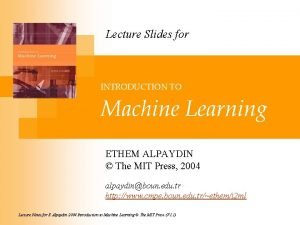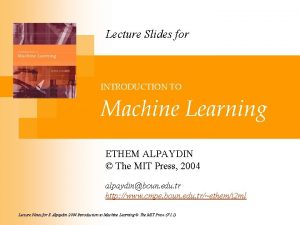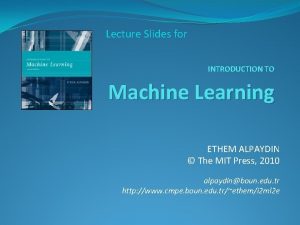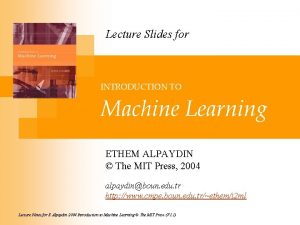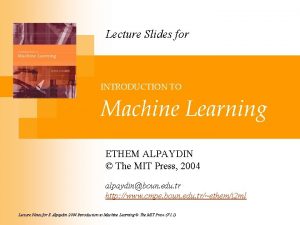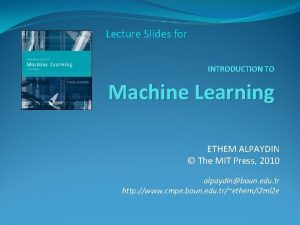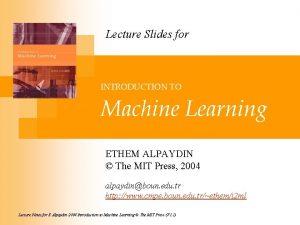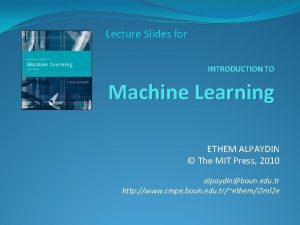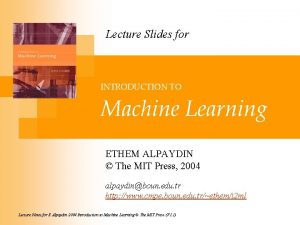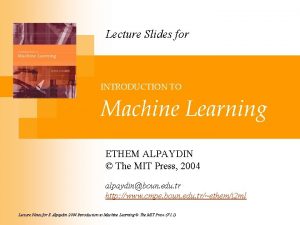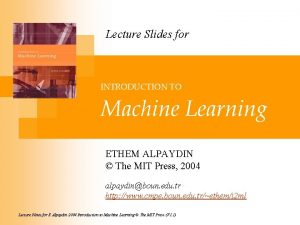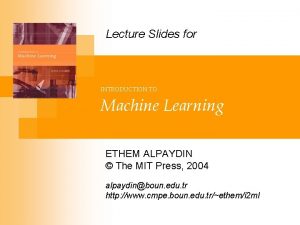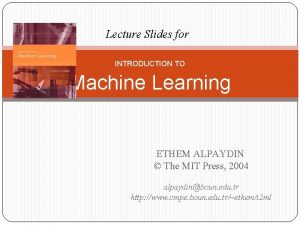Lecture Slides for INTRODUCTION TO Machine Learning ETHEM























- Slides: 23

Lecture Slides for INTRODUCTION TO Machine Learning ETHEM ALPAYDIN © The MIT Press, 2004 alpaydin@boun. edu. tr http: //www. cmpe. boun. edu. tr/~ethem/i 2 ml

Outline n Discriminant Function n Learning Association Rules n Naïve Bayes Classifier n Example: Play Tennis n Relevant Issues n Conclusions 2

What is discriminant Function n For classification problem, for each class, define a function such that we choose Ci if 3 Lecture Notes for E Alpaydın 2004 Introduction to Machine Learning © The MIT Press (V 1. 1)

Discriminant Functions K decision regions R 1, . . . , RK 4 Lecture Notes for E Alpaydın 2004 Introduction to Machine Learning © The MIT Press (V 1. 1)

K=2 Classes n Dichotomizer (K=2) vs Polychotomizer (K>2) g(x) = g 1(x) – g 2(x) n Log odds: n 5 Lecture Notes for E Alpaydın 2004 Introduction to Machine Learning © The MIT Press (V 1. 1)

Problem: Association Rule Mining INPUT A set of transactions Objective: Given a set of transactions D, generate all association rules that have support and confidence greater than the user-specified minimum support and minimum confidence. Minimize computation time by pruning. Constraints: Items should be in lexicographical order Association Rules {Diaper} {Beer}, {Milk, Bread} {Eggs, Coke}, {Beer, Bread} {Milk}, Real World Applications NCR (Terradata) does ARM for more than 20 large retail organizations including Walmart. Used for pattern discovery in biological DBs.

Association Rules n Association rule: X Y Support (X Y): n Confidence (X Y): n Apriori algorithm (Agrawal et al. , 1996) 7 Lecture Notes for E Alpaydın 2004 Introduction to Machine Learning © The MIT Press (V 1. 1)

Apriori Algorithm: Breadth First Search {} a ab b a d c d bd abd 8 ICDM'06 Panel

Apriori Algorithm Examples Problem Decomposition If the minimum support is 50%, then {Shoes, Jacket} is the only 2 - itemset that satisfies the minimum support. If the minimum confidence is 50%, then the only two rules generated from this 2 -itemset, that have confidence greater than 50%, are: 9

The Apriori Algorithm — Example Min support =50% Database D L 1 C 1 Scan D C 2 Scan D L 2 C 3 Scan D L 3 10

Naive Bayes’ Classifier Given C, xj are independent: p(x|C) = p(x 1|C) p(x 2|C). . . p(xd|C) 11 Lecture Notes for E Alpaydın 2004 Introduction to Machine Learning © The MIT Press (V 1. 1)

Background n There are three methods to establish a classifier a) Model a classification rule directly Examples: k-NN, decision trees, perceptron, SVM b) Model the probability of class memberships given input data Example: multi-layered perceptron with the cross-entropy cost c) Make a probabilistic model of data within each class Examples: naive Bayes, model based classifiers n a) and b) are examples of discriminative classification n c) is an example of generative classification n b) and c) are both examples of probabilistic classification 12

Probability Basics • Prior, conditional and joint probability – Prior probability: – Conditional probability: – Joint probability: – Relationship: – Independence: • Bayesian Rule 13

Probabilistic Classification • Establishing a probabilistic model for classification – Discriminative model – Generative model • MAP classification rule – MAP: Maximum A Posterior – Assign x to c* if • Generative classification with the MAP rule – Apply Bayesian rule to convert: 14

Naïve Bayes • Bayes classification Difficulty: learning the joint probability • Naïve Bayes classification – Making the assumption that all input attributes are independent – MAP classification rule 15

Naïve Bayes • Naïve Bayes Algorithm (for discrete input attributes) – Learning Phase: Given a training set S, Output: conditional probability tables; for elements – Test Phase: Given an unknown instance , Look up tables to assign the label c* to X’ if 16

Example • Example: Play Tennis 17

Example • Learning Phase Outlook Play=Yes Play=No Sunny Overcast Rain Humidity High Normal 2/9 4/9 3/5 0/5 2/5 Temperatur e Play=Yes Play=No Hot 2/9 4/9 3/9 2/5 1/5 Mild Cool Play=Ye Play=N s o 3/9 6/9 4/5 1/5 P(Play=Yes) = 9/14 Wind Strong Weak Play=Yes Play=No 3/9 6/9 3/5 2/5 P(Play=No) = 5/14 18

Example • Test Phase – Given a new instance, x’=(Outlook=Sunny, Temperature=Cool, Humidity=High, Wind=Strong) – Look up tables P(Outlook=Sunny|Play=Yes) = 2/9 P(Outlook=Sunny|Play=No) = 3/5 P(Wind=Strong|Play=Yes) = 3/9 P(Wind=Strong|Play=No) = 3/5 P(Temperature=Cool|Play=Yes) = 3/9 P(Temperature=Cool|Play==No) = 1/5 P(Huminity=High|Play=No) = 4/5 P(Huminity=High|Play=Yes) = 3/9 P(Play=Yes) = 9/14 P(Play=No) = 5/14 – MAP rule P(Yes|x’): [P(Sunny|Yes)P(Cool|Yes)P(High|Yes)P(Strong|Yes)]P(Play=Yes) = 0. 0053 P(No|x’): [P(Sunny|No) P(Cool|No)P(High|No)P(Strong|No)]P(Play=No) = 0. 0206 Given the fact P(Yes|x’) < P(No|x’), we label x’ to be “No”. 19

Example • Test Phase – Given a new instance, x’=(Outlook=Sunny, Temperature=Cool, Humidity=High, Wind=Strong) – Look up tables P(Outlook=Sunny|Play=Yes) = 2/9 P(Outlook=Sunny|Play=No) = 3/5 P(Wind=Strong|Play=Yes) = 3/9 P(Wind=Strong|Play=No) = 3/5 P(Temperature=Cool|Play=Yes) = 3/9 P(Temperature=Cool|Play==No) = 1/5 P(Huminity=High|Play=No) = 4/5 P(Huminity=High|Play=Yes) = 3/9 P(Play=Yes) = 9/14 P(Play=No) = 5/14 – MAP rule P(Yes|x’): [P(Sunny|Yes)P(Cool|Yes)P(High|Yes)P(Strong|Yes)]P(Play=Yes) = 0. 0053 P(No|x’): [P(Sunny|No) P(Cool|No)P(High|No)P(Strong|No)]P(Play=No) = 0. 0206 Given the fact P(Yes|x’) < P(No|x’), we label x’ to be “No”. 20

Relevant Issues • Violation of Independence Assumption – For many real world tasks, – Nevertheless, naïve Bayes works surprisingly well anyway! • Zero conditional probability Problem – If no example contains the attribute value – In this circumstance, during test – For a remedy, conditional probabilities estimated with 21

Relevant Issues • Continuous-valued Input Attributes – Numberless values for an attribute – Conditional probability modeled with the normal distribution – Learning Phase: Output: normal distributions and – Test Phase: • Calculate conditional probabilities with all the normal distributions • Apply the MAP rule to make a decision 22

Conclusions n n Naïve Bayes based on the independence assumption ¨ Training is very easy and fast; just requiring considering each attribute in each class separately ¨ Test is straightforward; just looking up tables or calculating conditional probabilities with normal distributions A popular generative model ¨ Performance competitive to most of state-of-the-art classifiers even in presence of violating independence assumption ¨ Many successful applications, e. g. , spam mail filtering ¨ Apart from classification, naïve Bayes can do more… 23
 Ethem alpaydin
Ethem alpaydin Introduction to machine learning ethem alpaydin
Introduction to machine learning ethem alpaydin Introduction to machine learning slides
Introduction to machine learning slides Introduction to machine learning ethem alpaydin
Introduction to machine learning ethem alpaydin Machine learning ethem alpaydin
Machine learning ethem alpaydin Ethem alpaydin
Ethem alpaydin Introduction to machine learning slides
Introduction to machine learning slides Machine learning lecture notes
Machine learning lecture notes Machine learning lecture notes
Machine learning lecture notes A small child slides down the four frictionless slides
A small child slides down the four frictionless slides Energy of four forces quick check
Energy of four forces quick check Principles of economics powerpoint lecture slides
Principles of economics powerpoint lecture slides Business communication lecture slides
Business communication lecture slides 01:640:244 lecture notes - lecture 15: plat, idah, farad
01:640:244 lecture notes - lecture 15: plat, idah, farad Concept learning task in machine learning
Concept learning task in machine learning Analytical learning in machine learning
Analytical learning in machine learning Pac learning model in machine learning
Pac learning model in machine learning Pac learning model in machine learning
Pac learning model in machine learning Inductive and analytical learning
Inductive and analytical learning Combining inductive and analytical learning
Combining inductive and analytical learning Instance based learning in machine learning
Instance based learning in machine learning Inductive learning machine learning
Inductive learning machine learning First order rule learning in machine learning
First order rule learning in machine learning Eager learning
Eager learning
